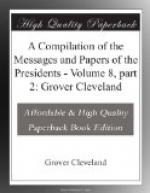On the demand of the holders these Treasury notes were to be redeemed in gold or silver coin, in the discretion of the Secretary of the Treasury; but it was declared as a part of this redemption provision that it was “the established policy of the United States to maintain the two metals on a parity with each other upon the present legal ratio or such ratio as may be provided by law.” The money coined from such bullion was to be standard silver dollars, and after directing the immediate coinage of a little less than 28,000,000 ounces the law provided that as much of the remaining bullion should be thereafter coined as might be necessary to provide for the redemption of the Treasury notes issued on its purchase, and that “any gain or seigniorage arising from such coinage shall be accounted for and paid into the Treasury.”
This gain or seigniorage evidently indicates so much of the bullion owned by the Government as should remain after using a sufficient amount to coin as many standard silver dollars as should equal in number the dollars represented by the Treasury notes issued in payment of the entire quantity of bullion. These Treasury notes now outstanding and in circulation amount to $152,951,280, and although there has been thus far but a comparatively small amount of this bullion coined, yet the so-called gain or seigniorage, as above defined, which would arise from the coinage of the entire mass has been easily ascertained to be a quantity of bullion sufficient to make when coined 55,156,681 standard silver dollars.
Considering the present intrinsic relation between gold and silver, the maintenance of the parity between the two metals, as mentioned in this law, can mean nothing less than the maintenance of such a parity in the estimation and confidence of the people who use our money in their daily transactions. Manifestly the maintenance of this parity can only be accomplished, so far as it is affected by these Treasury notes and in the estimation of the holders of the same, by giving to such holders on their redemption the coin, whether it is gold or silver, which they prefer. It follows that while in terms the law leaves the choice of coin to be paid on such redemption to the discretion of the Secretary of the Treasury, the exercise of this discretion, if opposed to the demands of the holder, is entirely inconsistent with the effective and beneficial maintenance of the parity between the two metals.
If both gold and silver are to serve us as money and if they together are to supply to our people a safe and stable currency, the necessity of preserving this parity is obvious. Such necessity has been repeatedly conceded in the platforms of both political parties and in our Federal statutes. It is nowhere more emphatically recognized than in the recent law which repealed the provision under which the bullion now on hand was purchased. This law insists upon the “maintenance of the parity in value of the coins of the two metals and the equal power of every dollar at all times in the markets and in the payment of debts.”




